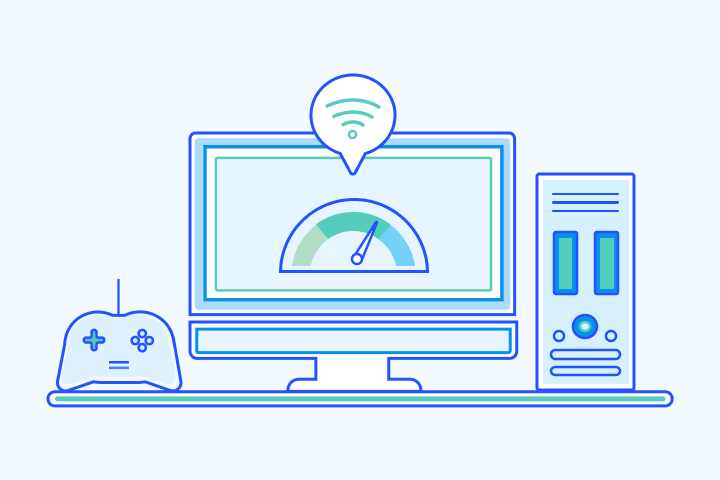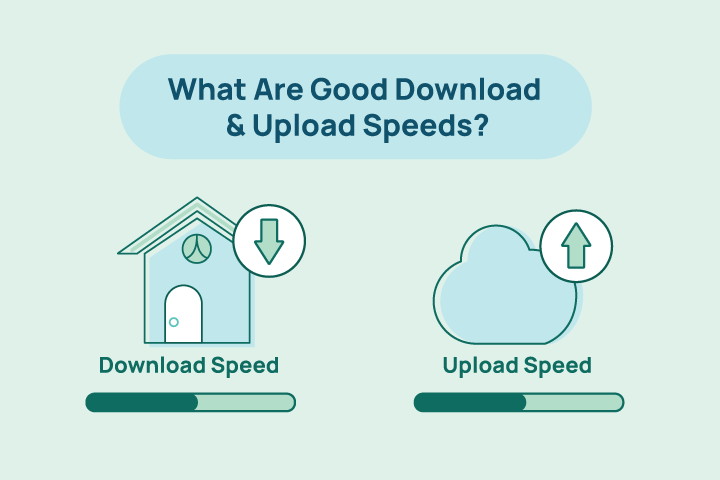Satellite Internet vs DSL: Which is Better?

HighSpeedOptions prides itself on providing honest, quality content. While we may be compensated when you make a purchase through links on our site, all opinions are our own. Here's how we make money.
Table of Contents
Satellite and DSL internet are among the most widely available internet options in the United States. In 2024, the U.S. Census Bureau reported that more than 90 percent of American households had access to broadband internet. However, one-third of rural residents do not have any broadband internet options. The lack of rural internet options is often tied to access and service availability.
The FCC defines broadband internet as a connection with at least 100 Mbps download and 20 Mbps upload speeds.
For customers in these areas, the options are limited. The only choices are often satellite internet and DSL internet. If you live in a rural area and these are your choices, understanding the differences between these types of internet connections is key to choosing which is better for your needs.
Our comparison guide of Satellite vs. DSL internet will help you make an informed decision.
Key Takeaways: Comparing DSL vs. Satellite Internet
- Availability: Satellite is available almost everywhere; DSL depends on phone line access and distance to a hub.
- Speed: DSL offers 15–150 Mbps; traditional satellite up to 100 Mbps; Starlink up to 200 Mbps.
- Latency: DSL (10–70 ms) is better for gaming/video calls. Traditional satellite has high latency (500–1200 ms); Starlink is lower (20–40 ms).
- Pricing: DSL and traditional satellite start around $40/month; Starlink starts at $80/month.
- Reliability: DSL is more stable; satellite can be affected by weather and obstructions.
Best for Budget: DSL
Best for Speed: Starlink
Best for Availability: Satellite
Best for Stability: DSL
What is Satellite Internet?
Satellite internet uses geosynchronous satellites to deliver broadband access, making it ideal for remote areas without cable or fiber infrastructure. While slower than fiber internet, it can reach speeds of 200 Mbps, depending on the provider.
However, satellite signal reliability can be affected by weather, trees, or obstructions, and the satellite dish requires proper alignment and occasional maintenance. Your property must have an unobstructed view of the sky for satellite internet to work properly.
Costs for satellite service vary from $40-$150 per month, depending on the speed, provider, and the amount of high-speed data included in your plan. HughesNet plans are often more affordable.
Pros
Available virtually everywhere
Faster than dial-up
Can overcome physical barriers
Cons
Tends to be expensive
Data caps are common
Unreliable due to physical elements
Top Satellite Internet Providers
- Fast satellite internet
- Ideal for rural areas
- Up to 3x faster than DSL*
- Best internet protection
- Unlimited data included
- No credit checks
What is DSL Internet?
DSL is considered the first broadband internet and was a welcome replacement for the slow, laggy speeds of dial-up internet. DSL delivers internet through telephone lines using a separate frequency from voice calls, enabling speeds up to 150 Mbps when close to the provider’s hub.
While cable and fiber internet are faster choices, DSL has more availability for internet in rural areas. It’s a convenient, always-on service that’s proven highly reliable. Unlike satellite internet, it’s not impacted by weather, but damage to the line can interrupt service.
In most places, 15-50 Mbps download is the max range, but with slower upload speeds. That can make online gaming speeds and video conferencing lag quite a bit, and the more devices you have on your home network, the more pronounced the lag will be.
One of the benefits of DSL is that it is one of the more affordable internet options, with plans starting at about $40 per month. The price depends on your provider and your chosen speed/data package. While you don’t need an active phone line, DSL does require a landline connection to deliver service.The government has invested in DSL and other wired internet options. The USDA’s ReConnect program has invested more than $1 billion to date to expand high-speed access to rural and tribal areas.
Pros
Affordable
More availability than other ground-based internet types
Faster than dial-up
Cons
Slow to average speeds
Doesn’t support gaming well
Speed depends on proximity to the provider’s hub
Top DSL Internet Providers
- Simplified pricing
- Unlimited data included
- No annual contract required
- Best internet protection
- Unlimited data included
- No credit checks
- Fast symmetrical speeds
- Fiber-optics network
- No annual contracts
What are the Differences Between Satellite Internet & DSL?
Satellite and DSL internet are very different types of internet connections. One is a form of wireless connectivity, and the other relies on copper wires for connectivity. The one similarity they share is their wide availability. Satellite, however, holds an advantage here.
Availability
Nothing beats the availability of satellite internet. Viasat and HughesNet offer nationwide coverage, and you can access service from anywhere as long as you can see the southern sky.
DSL runs on phone lines, which are common in most homes. However, availability may be limited in rural areas that lack infrastructure or are too far from a provider’s hub.
Speed
HughesNet and Viasat offer download speeds up to 100 Mbps. Meanwhile, DSL download speeds are 15-50 Mbps in most locations. However, if you live close to a DSL network hub, you may get speeds up to 150 Mbps.
Both DSL and satellite internet are suitable for general browsing and email, but slower upload speeds can impact online gaming, video calls, or smart home connectivity.
The outlier here is Starlink satellite internet. Using an array of low-earth orbit (LEO) satellites, it is capable of speeds up to 200 Mbps.
Pricing
Satellite service is typically more expensive than DSL, but the price of higher-tier DSL plans may overlap with lower-tier satellite options. DSL and satellite internet often have installation or activation fees, and you might have a monthly equipment payment.
Starlink, which offers faster speeds, is more expensive. It starts at $80/month, whereas HughesNet’s entry point is $39.99/month.
Data Caps
Most DSL providers enforce data caps but may offer unlimited options at higher tiers. Satellite providers often advertise unlimited data but impose limits on high-speed usage. After exceeding your monthly allowance, your speeds may be throttled.
See our guide on internet provider data limits for an in-depth look at data caps.
Latency
DSL has lower internet latency (10–70 ms) than traditional satellite internet (500–1200 ms), making it more suitable for gaming and video calls. Starlink has improved latency at 20–40 ms.
DSL vs. Satellite Internet At-A-Glance
| Internet Type | Starting Price | Starting Speeds | Latency Range |
|---|---|---|---|
| DSL Internet | ~$40/month | 15–25 Mbps | 10–70 ms |
| Satellite Internet (Viasat/HughesNet) | ~$40/month | 25 Mbps | 500–1200 ms |
| Starlink Internet | $80/month | 50 Mbps | 20–40 ms |
| Internet Type | DSL Internet |
|---|---|
| Starting Price | ~$40/month |
| Starting Speeds | 15â25 Mbps |
| Latency Range | 10â70 ms |
| Internet Type | Satellite Internet (Viasat/HughesNet) |
| Starting Price | ~$40/month |
| Starting Speeds | 25 Mbps |
| Latency Range | 500â1200 ms |
| Internet Type | Starlink Internet |
| Starting Price | $80/month |
| Starting Speeds | 50 Mbps |
| Latency Range | 20â40 ms |
NOTES:
- DSL speeds and latency improve the closer you are to the provider’s hub.
- Satellite Internet refers to high-altitude geostationary providers like Viasat and HughesNet.
- Satellite Internet Top Speed varies by provider (for example, Viasat often tops out at 100 Mbps).
- Starlink uses low-Earth orbit satellites for faster speeds and lower latency, but comes with a higher upfront cost.
Which is Better, Satellite or DSL Internet?
If you’re deciding between satellite internet or DSL internet service, consider your:
- Internet needs
- Service availability in your area
- Budget
If you have a choice between DSL and satellite internet, here are our suggestions for the best option based on the above criteria:
- Best for Budget: DSL Internet
- Best for Speed: Starlink Satellite Internet
- Best for Availability: Satellite Internet
- Best for Stability: DSL Internet
Note: If you live close to your phone provider’s network hub, DSL may match or exceed the speed of satellite while offering better pricing and lower latency.
In some parts of the country, availability leaves you only one choice: satellite internet.
Drop your ZIP code in the search below the FAQs to find out what internet options are available in your area.
Frequently Asked Questions: DSL vs. Satellite Internet
It depends on your location and needs. DSL is generally more stable, with lower latency and lower cost. Satellite internet offers wider availability, especially in rural or remote areas without wired infrastructure.
In most cases, DSL and traditional satellite offer similar speeds (15–100 Mbps). However, Starlink satellite internet can reach speeds up to 200 Mbps, making it the fastest option of the three.
Satellite internet is typically the best rural internet option with limited infrastructure, as it’s available almost anywhere with a clear view of the sky. However, if DSL is available, it may offer a more stable connection with lower latency and often at a lower monthly cost. Starlink combines wide availability with higher speeds and lower latency but comes at a higher price point.
Traditional satellite internet has high latency (500–1200 ms), which can cause lag during online gaming. DSL is better for gaming due to lower latency (10–70 ms). Starlink improves satellite latency (20–40 ms), making it a more viable option.
DSL is typically the most affordable option, with plans starting around $40/month. Satellite internet may be the only available option in very remote locations, but it often comes with higher costs and data limitations.
DSL requires a landline connection to deliver service, but you don’t need active phone service. It uses a separate frequency on the phone line for internet access.
Find providers in your area

Table of Contents










